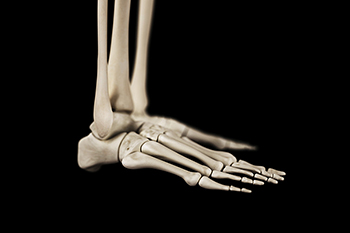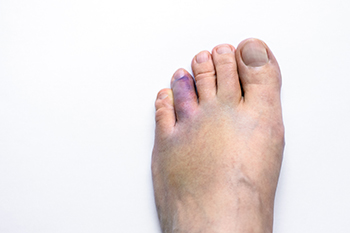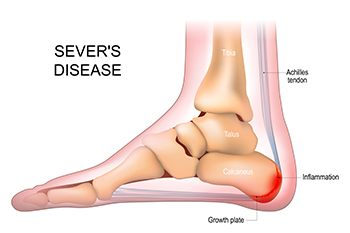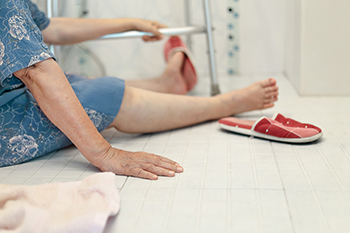January 2024
Gout Pain Can Be Managed
Diagnosis of Stress Fractures

A foot stress fracture is a microscopic crack in the bone, often caused by repetitive stress or overuse. This common injury can affect various bones in the foot, such as the metatarsals, and typically emerges gradually due to activities such as running or jumping. Recognizing the symptoms is vital, as persistent pain, swelling, and tenderness are common indicators. To diagnose a foot stress fracture, podiatrists employ a combination of clinical evaluation and imaging studies. X-rays may not immediately reveal the fracture, but MRI imaging or bone scans may offer more detailed insights. Medical history, physical examination, and a thorough discussion of the individual's activities contribute to an accurate diagnosis. Early detection is essential for effective management, often involving rest, modified activity, and sometimes bracing or casting. If you have foot pain, and believe it may be a stress fracture, it is suggested that you visit a podiatrist who can accurately diagnose and treat this condition.
Stress fractures occur when there is a tiny crack within a bone. To learn more, contact Dr. Michael A. Wood from Foot Health Institute. Our doctor can provide the care you need to keep you pain free and on your feet.
How Are They Caused?
Stress fractures are the result of repetitive force being placed on the bone. Since the lower leg and feet often carry most of the body’s weight, stress fractures are likely to occur in these areas. If you rush into a new exercise, you are more likely to develop a stress fracture since you are starting too much, too soon. Pain resulting from stress fractures may go unnoticed at first, however it may start to worsen over time.
Risk Factors
- Gender – They are more commonly found in women compared to men.
- Foot Problems – People with unusual arches in their feet are more likely to develop stress fractures.
- Certain Sports – Dancers, gymnasts, tennis players, runners, and basketball players are more likely to develop stress fractures.
- Lack of Nutrients – A lack of vitamin D and calcium may weaken the bones and make you more prone to stress fractures
- Weak Bones – Osteoporosis can weaken the bones therefore resulting in stress fractures
Stress fractures do not always heal properly, so it is important that you seek help from a podiatrist if you suspect you may have one. Ignoring your stress fracture may cause it to worsen, and you may develop chronic pain as well as additional fractures.
If you have any questions, please feel free to contact one of our offices located in Lansing, and Chicago, IL . We offer the newest diagnostic and treatment technologies for all your foot care needs.
Symptoms and Long-Term Implications of a Broken Toe

A broken toe, though seemingly minor, can yield noticeable symptoms and potential long-term complications. Immediate signs include pain, swelling, and bruising around the affected toe. Limited mobility and difficulty bearing weight are common, making daily activities challenging. If left untreated, a broken toe may lead to complications, such as deformities where the toe heals in a misaligned position. Chronic pain can persist, hindering mobility. In some cases, arthritis may develop, accelerating joint degeneration over time. Nerve damage is another potential consequence, causing tingling or numbness. Seeking prompt medical attention, including having X-rays taken for an accurate diagnosis, is vital to ensure proper realignment and minimize the risk of enduring complications. If you have endured a broken toe, it is suggested that you visit a podiatrist who can effectively treat this condition and guide you toward avoiding long-term complications.
A broken toe can be very painful and lead to complications if not properly fixed. If you have any concerns about your feet, contact Dr. Michael A. Wood from Foot Health Institute. Our doctor will treat your foot and ankle needs.
What to Know About a Broken Toe
Although most people try to avoid foot trauma such as banging, stubbing, or dropping heavy objects on their feet, the unfortunate fact is that it is a common occurrence. Given the fact that toes are positioned in front of the feet, they typically sustain the brunt of such trauma. When trauma occurs to a toe, the result can be a painful break (fracture).
Symptoms of a Broken Toe
- Throbbing pain
- Swelling
- Bruising on the skin and toenail
- The inability to move the toe
- Toe appears crooked or disfigured
- Tingling or numbness in the toe
Generally, it is best to stay off of the injured toe with the affected foot elevated.
Severe toe fractures may be treated with a splint, cast, and in some cases, minor surgery. Due to its position and the pressure it endures with daily activity, future complications can occur if the big toe is not properly treated.
If you have any questions please feel free to contact one of our offices located in Lansing, and Chicago, IL . We offer the newest diagnostic and treatment technologies for all your foot and ankle needs.
Managing a Child’s Heel Pain

Navigating a child's heel pain, particularly in the context of Sever's disease, demands careful attention. This condition primarily targets children during their adolescent growth spurts, typically affecting girls aged 8 to 13 and boys aged 10 to 15. As children grow, their bones elongate from growth plates, soft areas of cartilage near the ends of bones, which eventually solidify. Sever’s disease arises when the calf muscle and Achilles tendon excessively pull on the immature heel bone, which continues to develop until approximately age 15. Athletes engaged in high-impact sports face a higher risk for Sever's disease, but less active children can also be affected. Symptoms include pain on the sides or margins of the heel, which may increase with activities like standing on tiptoes or running. Diagnosis relies on symptoms, as X-rays cannot confirm Sever's disease but may rule out other causes. While symptoms may persist for several months, prompt recognition and appropriate intervention can help children effectively manage and alleviate the heel pain associated with Sever’s disease. For help in managing your child’s heel pain, it is suggested that you schedule an appointment with a podiatrist.
Sever's disease often occurs in children and teens. If your child is experiencing foot or ankle pain, see Dr. Michael A. Wood from Foot Health Institute. Our doctor can treat your child’s foot and ankle needs.
Sever’s Disease
Sever’s disease is also known as calcaneal apophysitis, which is a medical condition that causes heel pain I none or both feet. The disease is known to affect children between the ages of 8 and 14.
Sever’s disease occurs when part of the child’s heel known as the growth plate (calcaneal epiphysis) is attached to the Achilles tendon. This area can suffer injury when the muscles and tendons of the growing foot do not keep pace with bone growth. Therefore, the constant pain which one experiences at the back of the heel will make the child unable to put any weight on the heel. The child is then forced to walk on their toes.
Symptoms
Acute pain – Pain associated with Sever’s disease is usually felt in the heel when the child engages in physical activity such as walking, jumping and or running.
Highly active – Children who are very active are among the most susceptible in experiencing Sever’s disease, because of the stress and tension placed on their feet.
If you have any questions, please feel free to contact one of our offices located in Lansing, and Chicago, IL . We offer the newest diagnostic and treatment technologies for all your foot and ankle injuries.
Key Facts About Children’s Feet

Children's feet undergo remarkable changes and development throughout their early years, playing a pivotal role in their overall well-being. During infancy, a child's feet have a soft and pliable structure, gradually forming the arches over time. It is essential to allow infants to kick and stretch their feet freely, aiding in natural muscle development. As children begin to walk, usually around their 12 to 18 months, selecting proper footwear becomes critical. Shoes should provide ample support without constricting movement. Flat feet are common in toddlers, but arch development generally progresses with age. Regular observation is vital to detect any irregularities or signs of discomfort. Children's feet grow rapidly, necessitating regular shoe size checks and replacements. Additionally, fostering good hygiene practices, such as keeping toenails properly trimmed and addressing any foot pain promptly, contributes to the overall health and well-being of children's feet. If you notice any foot problems in your child, it is suggested that you visit a podiatrist who can perform an exam and determine the cause.
Making sure that your children maintain good foot health is very important as they grow. If you have any questions, contact Dr. Michael A. Wood of Foot Health Institute. Our doctor can provide the care you need to keep you pain-free and on your feet.
Keeping Children's Feet Healthy
Having healthy feet during childhood can help prevent medical problems later in life, namely in the back and legs. As children grow, their feet require different types of care. Here are some things to consider...
Although babies do not walk yet, it is still very important to take care of their feet.
Avoid putting tight shoes or socks on his or her feet.
Allow the baby to stretch and kick his or her feet to feel comfortable.
As a toddler, kids are now on the move and begin to develop differently. At this age, toddlers are getting a feel for walking, so don’t be alarmed if your toddler is unsteady or ‘walks funny’.
As your child gets older, it is important to teach them how to take care of their feet.
Show them proper hygiene to prevent infections such as fungus.
Be watchful for any pain or injury.
Have all injuries checked by a doctor as soon as possible.
Comfortable, protective shoes should always be worn, especially at play.
If you have any questions please feel free to contact one of our offices located in Lansing, and Chicago, IL . We offer the newest diagnostic and treatment technologies for all your foot and ankle needs.
Strategies to Prevent Falls in Every Room at Home

Creating a safe environment within each room of your house is vital to preventing falls and promoting overall well-being. In the bathroom, install non-slip mats and grab bars near the shower and toilet to enhance stability. Keep pathways clear in the living room, securing loose rugs and removing clutter that might pose a tripping hazard. Adequate lighting in the bedroom is essential for visibility, reducing the risk of stumbling in the dark. In the kitchen, ensure spills are promptly cleaned, and arrange commonly used items within easy reach to avoid unnecessary stretching or bending. Staircases demand sturdy handrails and proper lighting to facilitate safe navigation. Regularly inspect and maintain flooring in all rooms, addressing any uneven surfaces promptly. By incorporating these preventive measures throughout your home, you create a secure living space that minimizes the likelihood of falls, allowing you to move confidently and enjoy every room without the worry of potential accidents. If you require additional information about implementing fall prevention techniques which may help to protect the feet, it is suggested that you speak with a podiatrist.
Preventing falls among the elderly is very important. If you are older and have fallen or fear that you are prone to falling, consult with Dr. Michael A. Wood from Foot Health Institute. Our doctor will assess your condition and provide you with quality advice and care.
Every 11 seconds, an elderly American is being treated in an emergency room for a fall related injury. Falls are the leading cause of head and hip injuries for those 65 and older. Due to decreases in strength, balance, senses, and lack of awareness, elderly persons are very susceptible to falling. Thankfully, there are a number of things older persons can do to prevent falls.
How to Prevent Falls
Some effective methods that older persons can do to prevent falls include:
- Enrolling in strength and balance exercise program to increase balance and strength
- Periodically having your sight and hearing checked
- Discuss any medications you have with a doctor to see if it increases the risk of falling
- Clearing the house of falling hazards and installing devices like grab bars and railings
- Utilizing a walker or cane
- Wearing shoes that provide good support and cushioning
- Talking to family members about falling and increasing awareness
Falling can be a traumatic and embarrassing experience for elderly persons; this can make them less willing to leave the house, and less willing to talk to someone about their fears of falling. Doing such things, however, will increase the likelihood of tripping or losing one’s balance. Knowing the causes of falling and how to prevent them is the best way to mitigate the risk of serious injury.
If you have any questions, please feel free to contact one of our offices located in Lansing, and Chicago, IL . We offer the newest diagnostic and treatment technologies for all your foot care needs.





